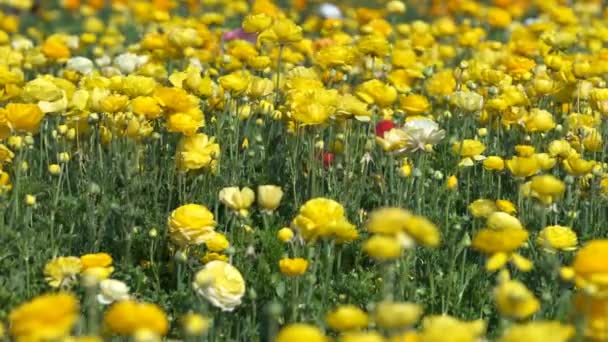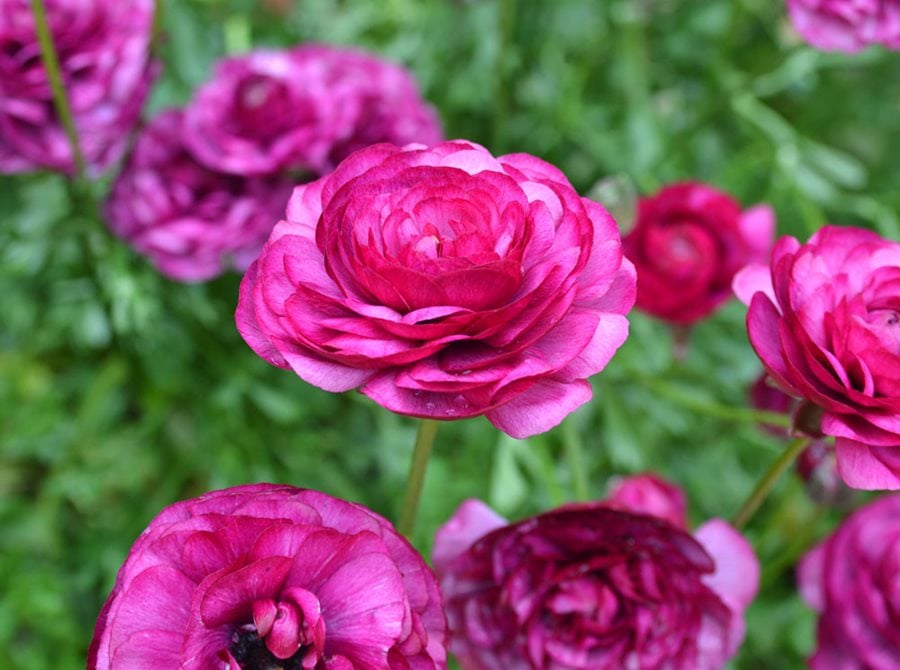Asiatic ranunculus flowers image by Chad McDermott from Fotolia.com They produce showy, 3- to 3 1/2-inch wide, cup-shaped blossoms that are so delicate they closely resemble tissue-paper flowers. Ranunculus come in a wide variety of colors, including red, yellow, white, pink and orange. All buttercup species are poisonous to rabbits. This includes the flower, leaves, stem, and roots. For the most part, buttercup plants are not highly dangerous to rabbits unless consumed in very large quantities. They most likely will cause digestive problems or inflammation in a rabbit’s mouth. A digitally drawn pink Asiatic Buttercup. Dimensions 3600 x 3600 px Perfect for print on fabric, scrapbooking, paper crafts, clothing, stickers etc. DIY invitations & announcements, cake toppers, labels & stickers, stationery, gifts. Adored by florists and gardeners, Ranunculus asiaticus (Persian Buttercups) is a tuberous-rooted plant boasting brilliantly colored flowers adorned with multiple layers of delicate, crepe paper-thin petals. Sicilian Buttercup Characteristics 1. Size and Weight. Sicilian Buttercup chickens are a rather petite bird. The average weight of a Sicilian Buttercup is between 4 and 5 pounds. Paired with their tight fitting feathers, they just don’t exactly look like big birds! Their small size and large comb make them a very ideal breed for hot climates.
| General Information | |
|---|---|
| Symbol: | COCO3 |
| Group: | Monocot |
| Family: | Commelinaceae |
| Duration: | Annual |
| Growth Habit: | Forb/herb |
| Native Status: | CAN I L48 I |
| Data Source and Documentation | |
| Native | Introduced | Both | Absent/Unreported |
| Native, No County Data | Introduced, No County Data | Both, No County Data |
| Native Status: | |||||||||
| L48 | AK | HI | PR | VI | NAV | CAN | GL | SPM | NA |
Robert H. Mohlenbrock. USDA SCS. 1989. Midwest wetland flora: Field office illustrated guide to plant species. Midwest National Technical Center, Lincoln. Provided by USDA NRCS Wetland Science Institute (WSI). Usage Requirements.
©Larry Allain. USGS National Wetlands Research Center (NWRC). Usage Requirements.
©Thomas G. Barnes. Usage Requirements.
©Ted Bodner. James H. Miller and Karl V. Miller. 2005. Forest plants of the southeast and their wildlife uses. University of Georgia Press., Athens. Provided by University of Georgia Press. Scanned by Forestry Images. Usage Requirements.
©James H. Miller. James H. Miller and Karl V. Miller. 2005. Forest plants of the southeast and their wildlife uses. University of Georgia Press., Athens. Provided by University of Georgia Press. Scanned by Forestry Images. Usage Requirements.

©Elaine Haug. Provided by Smithsonian Institution, Department of Botany. United States, VA, Prince William Co., Dale City. Usage Requirements.
©Elaine Haug. Provided by Smithsonian Institution, Department of Botany. United States, VA, Prince William Co., Dale City. Usage Requirements.

©Jim Stasz. Usage Requirements.
Britton, N.L., and A. Brown. 1913. An illustrated flora of the northern United States, Canada and the British Possessions. 3 vols. Charles Scribner's Sons, New York. Vol. 1: 458. Provided by Kentucky Native Plant Society. Scanned by Omnitek Inc. Usage Requirements.
USDA NRCS. Wetland flora: Field office illustrated guide to plant species. USDA Natural Resources Conservation Service. Provided by NRCS National Wetland Team. Usage Requirements.
slideshow| Symbol | Scientific Name | Other Common Names |
|---|---|---|
| COCOC3 | Commelina communis L. var. communis | Asiatic dayflower |
| COCOL | Commelina communis L. var. ludens (Miq.) C.B. Clarke | Asiatic dayflower |
| CODE9 | Commelina debilis Ledeb. | |
| COWI4 | Commelina willdenowii Kunth |
| Rank | Scientific Name and Common Name |
|---|---|
| Kingdom | Plantae – Plants |
| Subkingdom | Tracheobionta – Vascular plants |
| Superdivision | Spermatophyta – Seed plants |
| Division | Magnoliophyta – Flowering plants |
| Class | Liliopsida – Monocotyledons |
| Subclass | Commelinidae |
| Order | Commelinales |
| Family | Commelinaceae – Spiderwort family |
| Genus | Commelina L. – dayflower |
| Species | Commelina communis L. – Asiatic dayflower |
| U.S. Weed Information | |
|---|---|
Asiatic dayflower This plant can be weedy or invasive according to the authoritative sources noted below.This plant may be known by one or more common names in different places, and some are listed above. Click on an acronym to view each weed list, or click here for a composite list of Weeds of the U.S. | |
| KY | Haragan, P.D.. 1991. Weeds of Kentucky and adjacent states: a field guide. The University Press of Kentucky. Lexington, Kentucky. |
| N'EAST | Uva, R.H., J.C. Neal,and J.M. DiTomaso. 1997. Weeds of the Northeast. Cornell University Press. Ithaca, New York. |
| SWSS | Southern Weed Science Society. 1998. Weeds of the United States and Canada. CD-ROM. Southern Weed Science Society. Champaign, Illinois. |
 Interpreting Wetland Status
Interpreting Wetland Status
| ||||||||||||||||
| More Accounts and Images | |
|---|---|
| ARS Germplasm Resources Information Network (COCO3) | |
| Flora of North America (COCO3) | |
| Integrated Taxonomic Information System (COCO3) | |
| Integrated Taxonomic Information System (COCOC3) | |
| Integrated Taxonomic Information System (COCOL) | |
| Integrated Taxonomic Information System (CODE9) | |
| Integrated Taxonomic Information System (COWI4) | |
| USF Atlas of Florida Vascular Plants (COCO3) | |
| University of Tennessee Herbarium (Distribution) (COCO3) | |
| University of Wisconsin - Stevens Point Freckmann Herbarium (COCO3) | |
Food
| Source | Large Mammals | Small Mammals | Water Birds | Terrestrial Birds |
|---|---|---|---|---|
| Miller | Moderate | Low |
Cover
| Source | Large Mammals | Small Mammals | Water Birds | Terrestrial Birds |
|---|---|---|---|---|
| Miller |
Sources
| Miller, J.H., and K.V. Miller. 1999. Forest plants of the southeast and their wildlife uses. Southern Weed Science Society. |
Description of Values
| Value Class | Food | Cover |
|---|---|---|
| High | Average 25-50% of diet | Regular source of cover |
| Low | 5-10% of diet | Infrequently used as cover |
| Minor | 2-5% of diet | Sparsely used as cover |
| Moderate | Average 10-25% of diet | Occasional source of cover |
| Ranunculus asiaticus | |
|---|---|
| Scientific classification | |
| Kingdom: | Plantae |
| Clade: | Tracheophytes |
| Clade: | Angiosperms |
| Clade: | Eudicots |
| Order: | Ranunculales |
| Family: | Ranunculaceae |
| Genus: | Ranunculus |
| Species: | |
| Binomial name | |
| Ranunculus asiaticus | |
Ranunculus asiaticus, the Persian buttercup, is a species of buttercup (Ranunculus) native to the eastern Mediterranean region in southwestern Asia, southeastern Europe (Crete, Karpathos and Rhodes), and northeastern Africa.[1]
Asiatic Buttercup
It is a herbaceousperennial plant growing to 45 cm tall, with simple or branched stems. The basal leaves are three-lobed, with leaves higher on the stems more deeply divided; like the stems, they are downy or hairy. The flowers are 3–5 cm diameter, variably red to pink, yellow, or white, with one to several flowers on each stem.[2]
It is a protected species in some jurisdictions, including Israel.
Cultivation and uses[edit]
Double-flowered forms, which are likely hybrids, are a popular ornamental plant in gardens, and widely used in floristry. Numerous cultivars have been selected, including 'Bloomingdale', 'Picotee', 'Pot Dwarf', and 'Superbissima'. The plants can tolerate light frost, but are not hardy at temperatures below -10 °C.[2]
'Tecolote' and 'Bloomingdale' are examples of the double-flowered plants (not shown here). The single-flowered species form is not commercially cultivated on any significant scale. By contrast, the similar-looking Anemone coronaria is widely available in single-flower 'De Caen' hybrid forms. However, as with Ranunculus asiaticus, the species form, which also has red single flowers, is not commercially cultivated.
Asiatic Buttercup (ranunculus Asiaticus)
References[edit]
- ^'Ranunculus asiaticus'. Germplasm Resources Information Network (GRIN). Agricultural Research Service (ARS), United States Department of Agriculture (USDA). Retrieved 16 January 2018.
- ^ abHuxley, A., ed. (1992). New RHS Dictionary of Gardening. Macmillan ISBN0-333-47494-5.
External links[edit]
Asiatic Buttercup
- Media related to Ranunculus asiaticus at Wikimedia Commons

